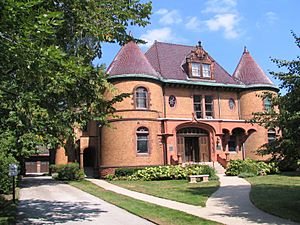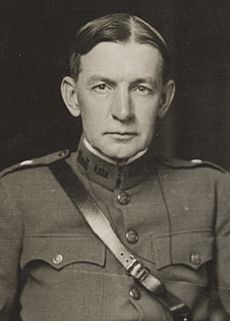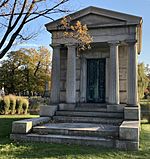Charles G. Dawes facts for kids
Quick facts for kids
Charles G. Dawes
|
|
|---|---|

Dawes, c. 1920s
|
|
| 30th Vice President of the United States | |
| In office March 4, 1925 – March 4, 1929 |
|
| President | Calvin Coolidge |
| Preceded by | Calvin Coolidge |
| Succeeded by | Charles Curtis |
| United States Ambassador to the United Kingdom | |
| In office June 15, 1929 – December 30, 1931 |
|
| President | Herbert Hoover |
| Preceded by | Alanson B. Houghton |
| Succeeded by | Andrew Mellon |
| 1st Director of the Bureau of the Budget | |
| In office June 23, 1921 – June 30, 1922 |
|
| President | Warren G. Harding |
| Preceded by | Position established |
| Succeeded by | Herbert Lord |
| 10th Comptroller of the Currency | |
| In office January 1, 1898 – September 30, 1901 |
|
| President | William McKinley Theodore Roosevelt |
| Preceded by | James H. Eckels |
| Succeeded by | William Ridgely |
| Personal details | |
| Born |
Charles Gates Dawes
August 27, 1865 Marietta, Ohio, U.S. |
| Died | April 23, 1951 (aged 85) Evanston, Illinois, U.S. |
| Resting place | Rosehill Cemetery |
| Political party | Republican |
| Spouse |
Caro Blymyer
(m. 1889) |
| Children | 4 |
| Education | Marietta College (AB) University of Cincinnati (LLB) |
| Civilian awards | Nobel Peace Prize |
| Signature |  |
| Military service | |
| Allegiance | United States |
| Branch/service | United States Army |
| Years of service | 1917–1919 |
| Rank | Brigadier general |
| Unit | American Expeditionary Forces Liquidation Commission of the War Department |
| Battles/wars | World War I |
| Military awards | Army Distinguished Service Medal |
Charles Gates Dawes (born August 27, 1865 – died April 23, 1951) was an important American figure. He was a banker, a general, and a diplomat. He also served as the 30th Vice President of the United States from 1925 to 1929. This was during the time Calvin Coolidge was president.
Dawes also won the Nobel Peace Prize in 1925. He received it for his work on the Dawes Plan. This plan helped Germany pay back money after World War I.
Born in Marietta, Ohio, Dawes studied law. He then started his career in Lincoln, Nebraska. He later became a successful gas plant executive. He helped William McKinley win the presidential election in 1896. After that, McKinley made Dawes the Comptroller of the Currency.
Dawes served as a general during World War I. He was in charge of buying supplies for American soldiers. In 1921, President Warren G. Harding chose him to be the first director of the Bureau of the Budget. He also worked on the Dawes Plan to help the German economy.
In 1924, Dawes became Calvin Coolidge's running mate. They won the election, and Dawes became Vice President in 1925. After his term, President Herbert Hoover appointed Dawes as the U.S. Ambassador to the United Kingdom. Dawes also helped lead the Reconstruction Finance Corporation. This group helped the country during the Great Depression. He passed away in 1951.
Contents
Early Life & Family History

Charles Dawes was born in Marietta, Ohio. His father, Rufus Dawes, was a general in the American Civil War. His uncle, Ephraim C. Dawes, was also a major in the army. He fought in important battles like Shiloh.
Charles had three brothers who became successful businessmen or politicians. Their names were Rufus C. Dawes, Beman Gates Dawes, and Henry May Dawes. He also had two sisters, Mary and Betsey.
His family had a long history in America. Charles was a descendant of Edward Doty, who came to America on the Mayflower. He was also related to William Dawes. William Dawes rode with Paul Revere during the American Revolution.
Charles Dawes married Caro Blymyer in 1889. They had a son, Rufus Fearing, and a daughter, Carolyn. They later adopted two more children, Dana and Virginia.
Education & Early Career
Charles Dawes went to Marietta College and graduated in 1884. He then studied law at Cincinnati Law School, finishing in 1886. He became a lawyer in Nebraska.
He practiced law in Lincoln, Nebraska, from 1887 to 1894. While there, he met John J. Pershing, who later became a famous army general. They became lifelong friends. Dawes also became friends with Congressman William Jennings Bryan.
In 1894, Dawes moved to Chicago. He started to buy gas plants in the Midwest. He became the president of gas companies in La Crosse, Wisconsin, and Evanston, Illinois.
A Musician & Composer
Charles Dawes was also a talented musician. He taught himself to play the piano and the flute. He even composed music.
His most famous piece was Melody in A Major, written in 1912. This song became very popular. In 1951, new words were added to it, and it became the song "It's All in the Game".
In 1958, Tommy Edwards's version of "It's All in the Game" became a number-one hit song. Many famous artists have recorded this song since then. These include Nat King Cole and Elton John.
Dawes is the only U.S. Vice President to have a number-one pop hit song. He is also one of only two people to win a Nobel Prize and have a number-one pop hit. The other is Bob Dylan.
Early Political Roles
Dawes's success in business caught the eye of Republican leaders. They asked him to help manage William McKinley's presidential campaign in Illinois in 1896. After McKinley won, Dawes was appointed Comptroller of the Currency.
He held this position from 1898 to 1901. During this time, he helped collect over $25 million from banks that had failed. He also made changes to banking rules to prevent future financial problems.
In 1901, Dawes left his government job. He wanted to become a U.S. Senator for Illinois. However, President Theodore Roosevelt supported his opponent, and Dawes did not win. After this, Dawes said he was done with politics. He then started the Central Trust Company of Illinois and was its president until 1921.
In 1912, Dawes's 21-year-old son, Rufus, sadly drowned. To honor his son, Dawes created homeless shelters in Chicago and Boston. He also helped build a dormitory at his son's school.
World War I Service
During World War I, Dawes joined the army in 1917. He quickly rose through the ranks. By October 1918, he was a brigadier general.
From 1917 to 1919, Dawes served in France. He was in charge of buying supplies for the American soldiers. He also helped create a board to coordinate supplies for all Allied forces.
After the war, he helped with the War Department's clean-up efforts. He received the Distinguished Service Medal from the U.S. and the Croix de Guerre from France for his service. He wrote a book about his wartime experiences called A Journal of the Great War.
In 1921, during a Senate hearing about war spending, Dawes famously said, "Hell and Maria, we weren't trying to keep a set of books over there, we were trying to win a war!" This quote earned him the nickname "Hell and Maria Dawes."
Helping Europe & Nobel Peace Prize
In 1921, President Warren G. Harding appointed Dawes as the first director of the Bureau of the Budget. This new office helped manage the government's money.
In 1923, Dawes was asked to help solve a big problem in Europe. Germany was struggling to pay back money after World War I. Dawes created the Dawes Plan. This plan arranged for American banks to loan money to Germany. This helped Germany's economy recover and allowed them to make payments to France and Belgium.
For his important work on the Dawes Plan, Charles Dawes shared the Nobel Peace Prize in 1925. The plan was later replaced by the Young Plan in 1929.
Vice Presidency (1925–1929)

In 1924, Calvin Coolidge was chosen to be the Republican presidential candidate. The party then chose Charles Dawes as his running mate for Vice President.
Dawes traveled across the country, giving speeches to support the Republican ticket. He often spoke out against Robert M. La Follette, a Progressive candidate. The Coolidge-Dawes team won the election in November 1924. They were sworn into office on March 4, 1925.
Speech to the Senate
On his first day as Vice President, Dawes gave a strong speech to the Senate. He criticized a Senate rule that allowed senators to delay votes. He called it "undemocratic." Dawes pointed at senators and hit the table to make his points. This speech surprised and annoyed many senators.
Nomination of Charles B. Warren
Soon after, the Senate debated President Coolidge's choice for Attorney General, Charles B. Warren. Many senators did not like Warren because of his past business ties. Dawes left the Senate chamber for a short break, thinking no vote would happen.
However, the senators decided to vote sooner than expected. The vote was tied, and Dawes was needed to break the tie. He rushed back, but by the time he arrived, one senator had changed their vote. The nomination failed. This incident was even made fun of in a poem.
Dawes and President Coolidge did not always agree. Dawes did not attend Cabinet meetings. He also continued to speak out against Senate rules. Dawes supported a bill called the McNary–Haugen Farm Relief Bill. This bill aimed to help farmers by having the government buy extra farm products. Dawes helped get the bill passed in Congress, but President Coolidge vetoed it.
In 1927, Coolidge decided not to run for re-election. Dawes hoped to be chosen as the next Vice President. However, Coolidge did not support Dawes for the role. Instead, Charles Curtis was chosen as Herbert Hoover's running mate.
After the Vice Presidency (1929–1951)
After his term as Vice President, Dawes became the U.S. Ambassador to the United Kingdom from 1929 to 1931. He was a good ambassador, even though he was known for being a bit rough around the edges. He famously refused to wear traditional knee breeches at the royal court.
As the Great Depression worsened, President Herbert Hoover asked Dawes to lead the new Reconstruction Finance Corporation (RFC). This group was created to help the country's economy. After a few months, Dawes left the RFC. He felt he needed to help his own bank, the Central Republic Bank and Trust Company of Chicago, which was struggling.
Some people accused Dawes of giving special treatment to his bank while leading the RFC. This ended his career in public service. In 1932, Dawes and others formed a new bank, the City National Bank and Trust Co. He served as its chairman until his death.
Charles Dawes passed away on April 23, 1951, at his home in Evanston, Illinois. He was 85 years old. He is buried in Rosehill Cemetery in Chicago.
Honors & Legacy
- In 1925, Dawes received the Nobel Peace Prize for his work on the Dawes Plan.
- Several places are named in his honor, including public schools in Chicago and Evanston, Illinois. Dawes Park in Evanston is also named after him.
Military Awards
- Distinguished Service Medal (United States)
- World War I Victory Medal (United States)
- Companion of the Order of the Bath (United Kingdom)
- Commander of the Legion of Honor (France)
- Commander of the Order of Leopold (Belgium)
- Croix de Guerre with palm (France)
In 1944, Dawes gave his home in Evanston to Northwestern University. It became the Evanston Historical Society, which is now the Evanston History Center. The house is a National Historic Landmark and is listed on the National Register of Historic Places. It is open as a museum today.
Selected Writings
- Dawes, C. G. (1894). The Banking System of the United States and Its Relation to the Money and the Business of the Country.
- ———— (1921). Journal of the Great War.
- ———— (1923). The First Year of the Budget of the United States.
- ———— (1935). Notes as Vice President, 1928–1929.
See also
 In Spanish: Charles G. Dawes para niños
In Spanish: Charles G. Dawes para niños
- List of covers of Time magazine (1920s) – December 14, 1925



